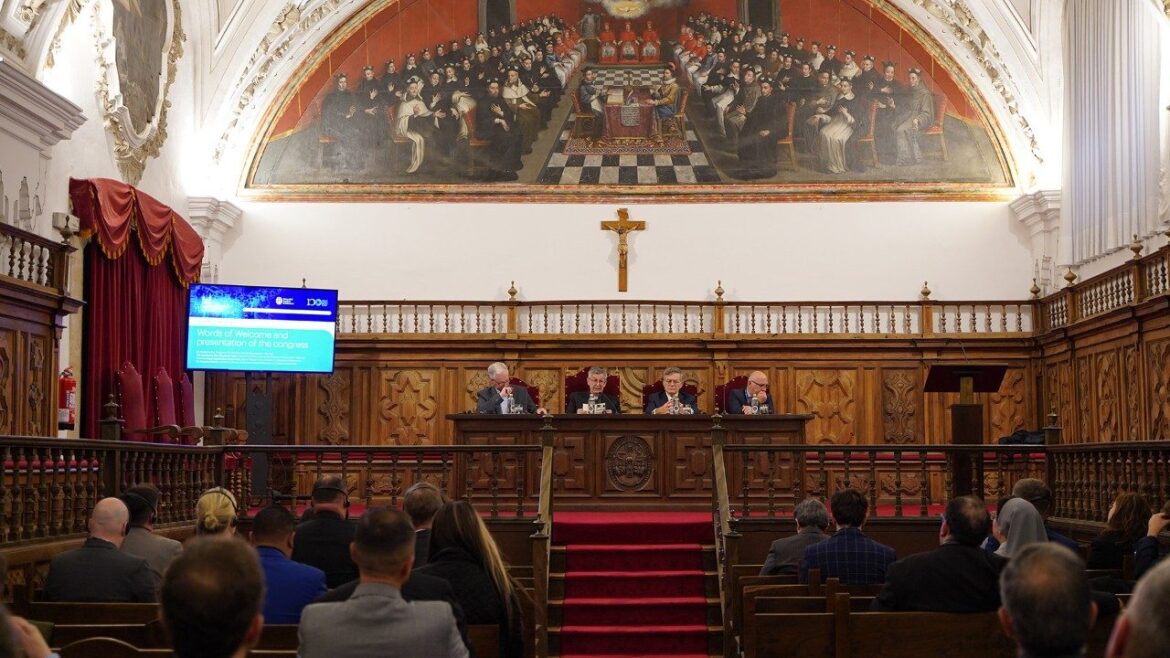
At an international conference held in Salamanca, Spain, the themes of communication and artificial intelligence are tied to the mission and challenges faced by Catholic universities. The prefect of the Dicastery for Communication, Paolo Ruffini, notes that AI is a gift, but cannot replace human intelligence.
By Amedeo Lomonaco
Exploring how internal dialogue strengthens identity and unites the university community around a shared mission marked themes discussed at the international congress held in Salamanca, Spain, on the theme: “Internal Communication in Catholic and Pontifical Institutions: limits and challenges.” The congress concluded on 14 November and was organized by the Pontifical University of Salamanca and the International Federation of Catholic Universities. Representatives from universities across Europe, Africa, South America, Asia, and Oceania attended the conference.
Communicating well to serve the Church
The event was opened on 12 November by the rector of the Pontifical University of Salamanca, Santiago García-Jalón de la Lama, who emphasized the importance of being artisans and mediators of understanding. “Communicating within a Catholic university,” he said, “means weaving bonds of truth, co-responsibility, and service. It means fostering a sense of being part of a common mission that transcends the individual. In Pontifical and Catholic institutions, good internal communication is also a way of serving the Church.”
AI, a gift to be used well
During the opening day of the conference, Paolo Ruffini, Prefect of the Dicastery for Communication, reminded participants that one of the Church’s core principles is “communication.” Regarding artificial intelligence, he emphasized that it must be seen as “a gift that can be used for good or ill.” He recalled how Artificial intelligence is a result of human intelligence, not its replacement, and that true intelligence unites reason, heart, and the capacity to feel, nourished by love. He went on to say that we should not entrust artificial intelligence with decisions that are human in nature and involve moral considerations and the ability to discern good from evil.
Paolo Ruffini also warned of the risks of dehumanized communication. He explained how communication ideally should be a network woven with truth and freedom, but it can risk being the opposite, isolating us. Given the distrust caused by the “infodemic of fake news,” he stressed the need to “rebuild trust in the truth and in our relationships with others,” promoting spaces for listening, reflection, and dialogue.
AI and education
Bishop Paul Tighe, Secretary of the Dicastery for Culture and Education, focused his talk on the theme “Catholic Universities in the Age of Artificial Intelligence.” He pointed out the need to educate with AI, but also to educate about AI and for AI in a world that is changing and in constant evolution. “Generative AI,” he said, “represents a significant transition, described as the Fourth Industrial Revolution, which requires a fundamental evolution of education to help prepare and form a generation that will live in a radically changed and constantly evolving world.”
In his speech, Bisop Tighe acknowledged the immense potential of AI for pedagogical innovation but also reminded the audience that the role of the teacher should not be underestimated, as it is rooted in the commitment to the integral, social, and emotional development of students. He noted that the development of the educational curriculum should prioritize both digital competence and digital literacy.
Challenges for Catholic universities
Bishop Tighe also urged not to “blindly follow” the results generated by AI, especially in areas where one lacks expertise. He explained how there is always an opinion and orientation within the algorithm. And the Church, he observed, must participate in the ongoing global debate on AI’s use. While we celebrate its potential, we must also analyze its ability to be something that nurtures humanity, he added. And Catholic universities have a unique opportunity to contribute to the world through their mission in education and formation. In Catholic universities, “it is possible to bring together the culture of science and the humanistic culture.” Catholic universities therefore must network because together, they can accomplish much more. On AI, an interdisciplinary and transdisciplinary approach is required. Finally, Bishop Tighe emphasized that theology and philosophy could find relevance and play a primary role in the AI arena.
Communication and culture
The conference concluded on 14 November with a speech by Paolo Ruffini, Prefect of the Dicastery for Communication, on what unites communication and culture. Referring to Pope Leo XIV’s speech to the members of Italy’s RCS Academy, he recalled that no one is a cog or a simple function. In today’s world, algorithms, which are designed to monetize every click, contaminate the infosphere. No answer is possible without knowledge, he noted, and no answer can be shared without communication. No algorithm will ever replace the beauty of human encounter in the sharing of knowledge. There is a need to “build bridges and alliances in the fields of culture, education, and communication.” The challenge is great. “And great,” concluded Paolo Ruffini, “is our responsibility,” noting how we must mend the rift between modernity and the Gospel message, between the civilization of machines, communication, and Christian civilization. This mission also calls upon the world of universities and communication. The concrete question is “how to build a new humanism,” not a world dominated and shaped by algorithms.

